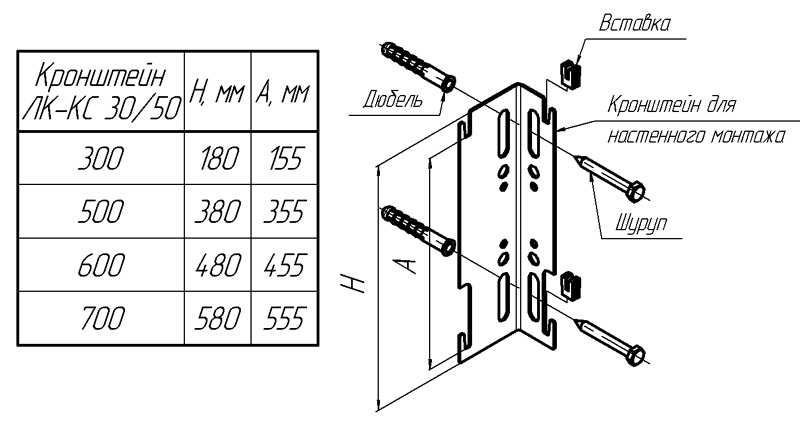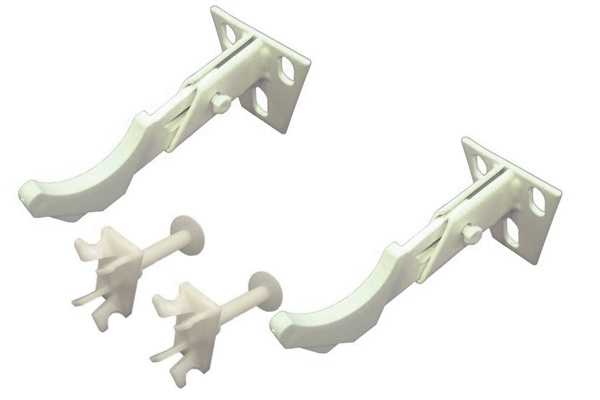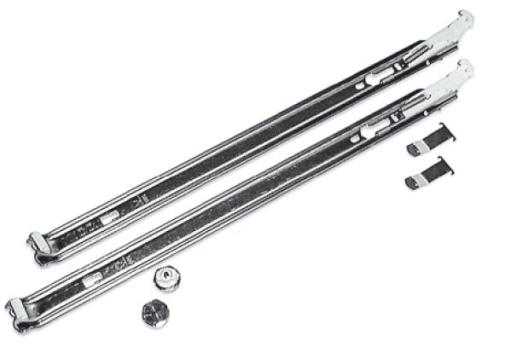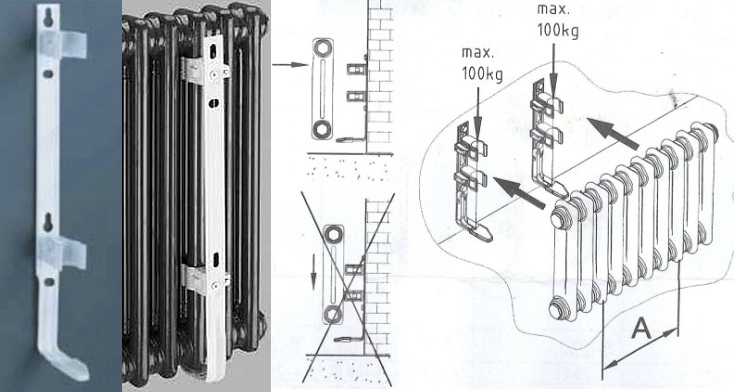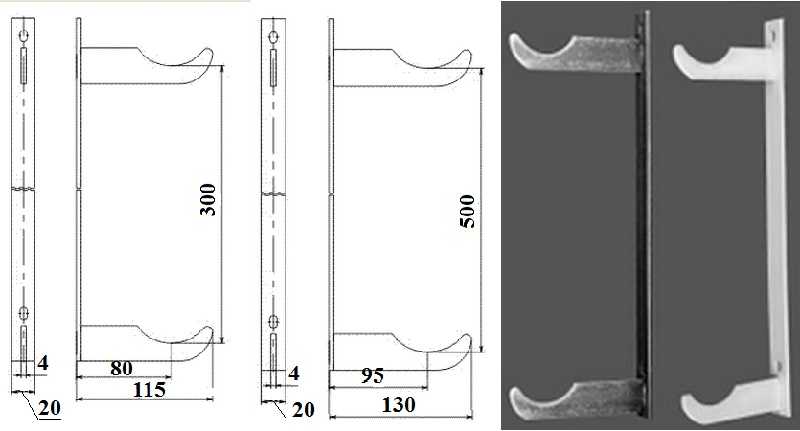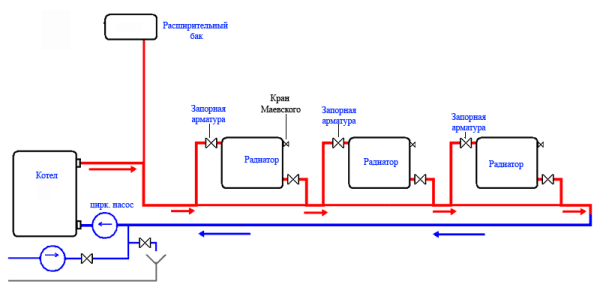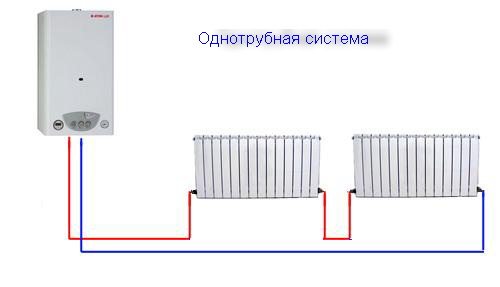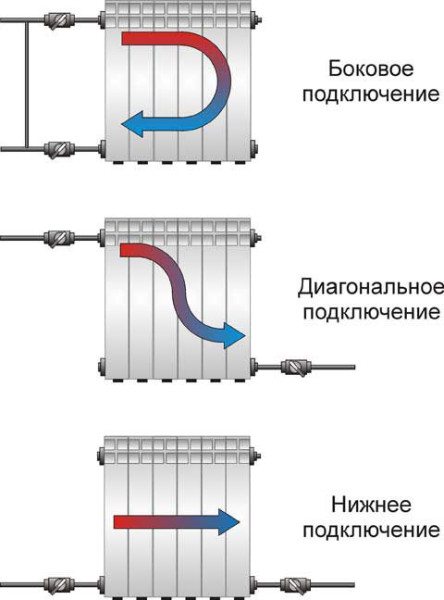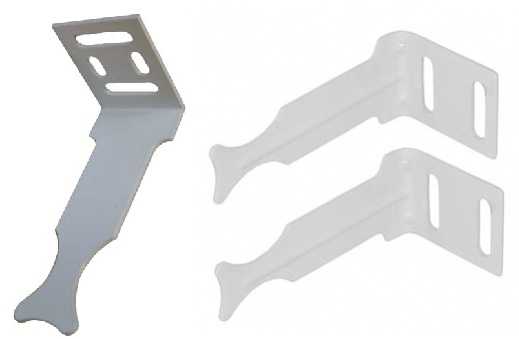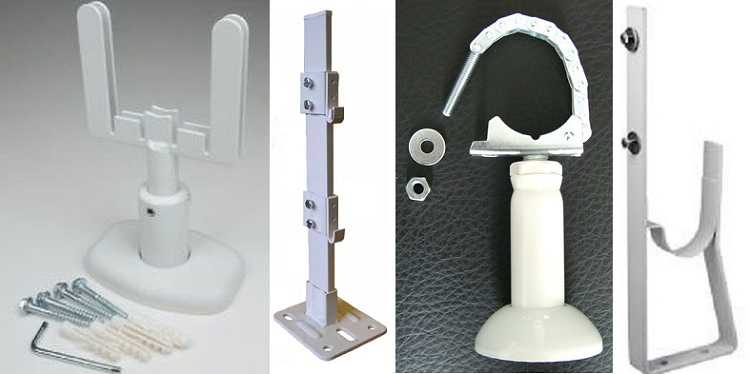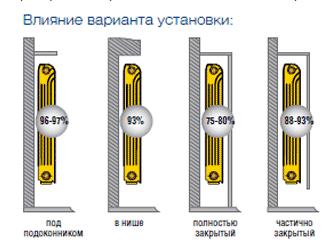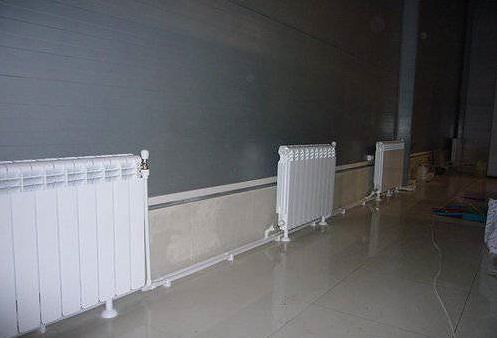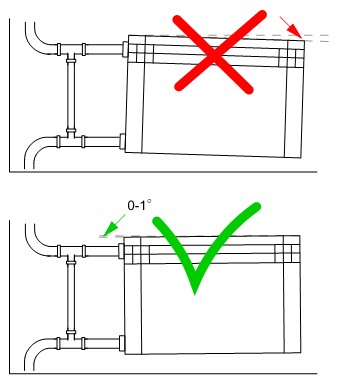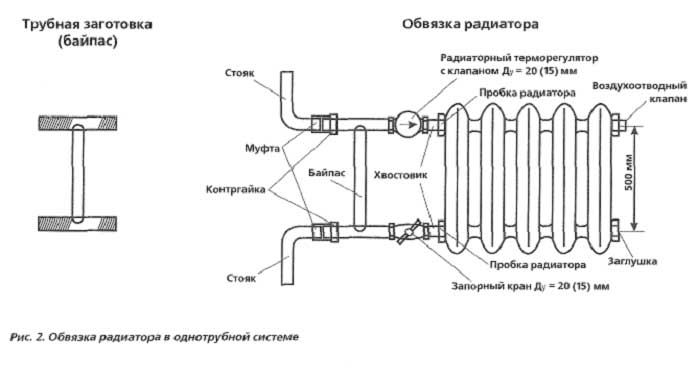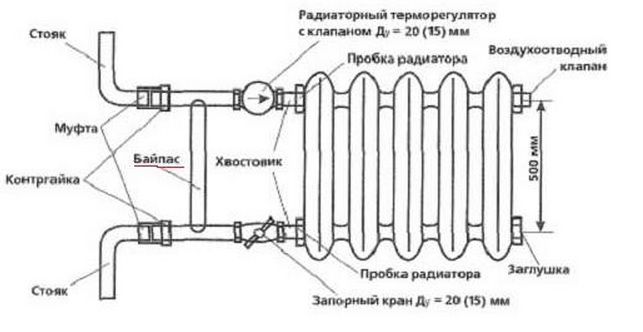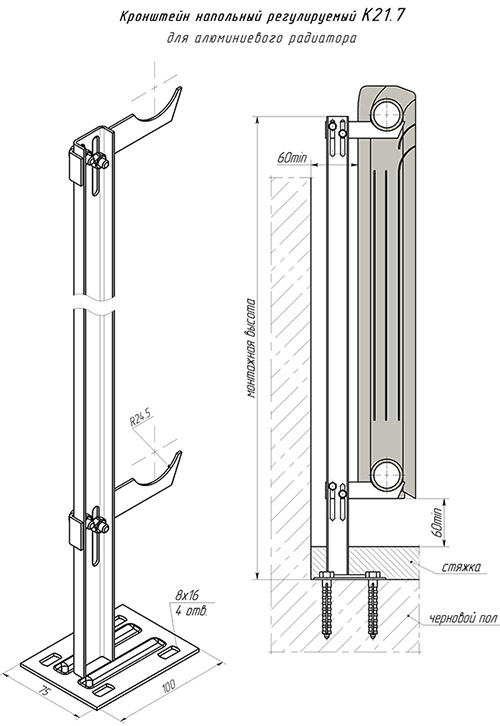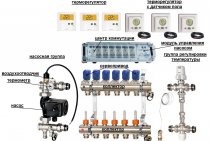Installation of cast iron radiators
The market for heating appliances is striking in its diversity. But familiar to everyone, cast iron radiators are still popular due to their many advantages. They are durable, resistant to corrosion, unpretentious in operation and very durable. But even the most reliable device may one day require replacement. The question of how to hang a heating radiator on brackets can be solved independently. The main thing is to have experience, the necessary materials and take into account some of the nuances of installation.

Modern cast iron radiators - an example of style
- Features of selection and installation
- Preliminary preparation
- The main stages of independent work
- Decorative design of radiators
Connection sequence
The most crucial moment in installing batteries is their connection to the heating circuit and subsequent verification. In order for all work to be carried out with high quality, it is necessary to follow the sequence of installation of a cast-iron radiator.
- The heating circuit is first turned off, the supply of coolant to the apartment is stopped, followed by draining it from the pipes using a circulation pump.
- The battery is hung on brackets with checking its horizontal and vertical position with a building level.
- Plugs are unscrewed from the device.
- In the event that the side connection scheme for cast-iron heating radiators is “introduced” into a single-pipe circuit, then you must first install and connect a bypass with a valve. If the system is two-pipe, then taps are used.
At the last stage, the Mayevsky crane is installed on cast-iron radiators.
After connecting all the heating elements, a trial check of the quality of work is carried out. It will show how securely the system is mounted. To do this, water is launched into it under pressure. If there is no leakage, no strange noises and knocks, then all the elements of the circuit are connected correctly.
The procedure for carrying out installation work
Installation of brackets for a cast-iron battery
First you need to determine the required number of brackets. It depends on the area of the heater. For 1 sq.m. heating surface need 1 bracket. Calculate the surface area of the radiator depending on the number of sections of the device and mark the wall for mounting the brackets. After marking, check the calculations again, drill holes, insert dowels into them and screw in the fasteners.
Installing a heating radiator
The heating circuit must be shut off and the water completely removed. The remaining coolant can be pumped out with a pump. The battery is hung on supports; for a single-pipe system, a bypass is connected. Next, the radiator is connected to the system using threaded rods. All joints must be sealed. For this, any sealing materials are suitable, usually tow is used. If you know how to handle a welding machine, take the opportunity and weld the joints of the spurs and the pipeline.
After installing the device, a pressure test is required. This procedure is performed by professionals with appropriate equipment. If you have a device, do everything yourself, but if not, then buying an expensive device for the sake of a one-time installation of one or more radiators is not advisable. After installation is complete, check the operation of the system.
Theoretically, there is nothing complicated in installing cast-iron heating radiators, but in practice, not everything is as easy as we would like. If you do not have the necessary experience or an assistant who has already done similar work, it is better to hire a team of plumbers. Of course, paying for their work will significantly increase the cost of the heating system as a whole, but you will save time, effort and nerves. The final decision is yours.
How to choose the right bracket
The main rule when buying a latch: it must withstand the weight placed on it. The maximum load is usually indicated in the attached instructions. It is easiest to choose a bracket for an aluminum radiator, as it weighs little and any type is suitable for it.
For very powerful batteries, take floor stands. But if the flooring in the house is wooden, then you need to make sure that the latches are equipped with additional fasteners to the wall. This is necessary in order to reduce the load on the boards. For light heating elements that will be located in a deep niche under the window, it is better to buy a long bracket.
It is recommended for cast iron radiators to take holders with the ability to slightly change the height, otherwise installation difficulties may arise. The price of an adjustable bracket is not so high as to give up the convenience of installation.
It is important that the composition of the alloy does not contain toxic substances released during heating. Do not buy parts from hand, especially without the appropriate accompanying documents
Please note that the lightest one - the corner bracket - is only for aluminum and copper radiators.
Fasteners for steel radiators
There are two different types in this group: tubular and panel radiators. They have a different design, respectively, a different mount.
In panel radiators, brackets are welded on the rear wall, with which they are hung on brackets. The shape of this type of fastener is different: it is designed specifically for staples.

In panel radiators, brackets are welded on the back wall
When installing panel radiators, it is necessary to strictly monitor the vertical position of the brackets. High precision required: four or six staples must hit the hooks exactly
It is also important that the wall is perfectly flat and smooth. In general, using conventional brackets, panel radiators are quite difficult to hang
It is easier to work with other types of holders.
Standard bracket for panel radiator
Since the mass of the heater is small, it is enough to fix it on the upper brackets, install stops at the bottom, which will give it a direction in the horizontal plane. They are not attached to the wall, but cling to the bracket with hooks and simply rest against the wall. For reliability, the part that faces the wall is expanded.
This is how a set of brackets for tubular steel batteries looks like: the upper collector is hung on the hooks, and plastic stops are placed below
There are also special mounting brackets for easy mounting. They are a strip of metal with plastic clips at the top and bottom. When using this mount, the brackets on the rear panel are not needed. The slats are fixed on the wall, a radiator is inserted into them, which is held with plastic hooks.
Plank for quick mounting of panel batteries
Fasteners for tubular radiators are similar to sectional ones: the same hooks, only of a different size, often equipped with plastic lining.
There is also a special fastener with SMB tube grips. This is a strip of steel with plastic clips and a shelf at the bottom, which serves as a support for the radiator. This mounting plate can be used if the weight of the device filled with water does not exceed 100 kg. Installation is simple: put the battery on a shelf, bring the top edge closer to the latches. They grab the nearest tube, a click is heard. The radiator is installed, you can connect the supply pipes.
Bracket for quick mounting of a tubular radiator with a shelf and clamps
There is a second option for quick mounting: SVD fasteners. It consists of two parts. One is attached to the radiator, the second, to the wall. Then they are connected to each other and fixed with a steel loop.

Another type of holders for tubular models: two parts, one is mounted on the wall, the second is fixed on the pipe. Between themselves, they are pulled together with a wire clamp.
Floor mounting for tubular radiators can be of several types: tubular stops that are welded at the factory, or racks with hooks. Radiators are hung on such racks, and the racks themselves are attached to the floor.
Brackets for radiators are of different types and types: for wall and floor installation. The standard ones that come with the kit are reliable, but working with them is more difficult. Planks and fast-mounting devices save time, but cost a lot.
Fasteners for cast iron, sectional, panel radiators
The order of installation of radiators does not depend on their type: the rules remain the same, only the fasteners change. If it is intended to be installed under a window, the following distances must be observed: from the floor should be at least 80-120 mm, to the window sill at least 60-100 mm, to the wall - 30-50 mm. It is also necessary to determine the number and location of fasteners.
The number of brackets (hooks) per battery depends on its length. If there are few sections - up to 8-10 pieces, then two holders are required at the top, and at least one more at the bottom. If there are more than 10 sections, three supports are installed on top and two on the bottom. For each next five to seven sections of cast iron radiators and ten tubular and aluminum, the number of fasteners increases: one holder is added on top and one on the bottom.
Ways to use various kinds of fasteners for sectional radiators
Fasteners for cast iron batteries
Since these are the heaviest heaters, the holders for them are also the most massive: they must hold a considerable weight for years. These can be individual or curved pins fixed on a bar. In any case, thicker metal is used in the manufacture of fasteners for cast iron batteries. In the price lists, it usually comes with the addition of "reinforced". Can be dyed (standard color is white) or not. Some manufacturers paint the desired color on request (specify the type of fastener and its color when ordering a radiator).

Fastening for a cast-iron battery and make it reinforced: from thicker metal
When buying, you will need to take into account the dimensions: fastening for sections of different depths is made on purpose, since it is necessary to ensure a distance to the wall of at least 3-5 cm.
In addition to brackets for cast-iron radiators, hooks are also produced. They are sold in pairs with dowels. They are installed as standard: a hole is drilled, a dowel is inserted into it, and a hook is screwed into the dowel (there is a thread on one side of it).
There are mounting brackets for cast iron radiators that make installation easier.
In addition to wall mounting, there are legs for floor installation. They are height adjustable or not. There are also different upper arcs that fix the section on the stop: there is an arc made of steel wire, and there is a chain of movably connected links. In both cases, the batteries are fixed to the support using these arcs and bolts.

Racks for floor installation of sectional radiators - any wall-mounted battery can be installed on the floor
Wiring diagrams
The most fault-tolerant scheme for connecting heating radiators in a private house with a bottling and a boiler is a single-pipe Leningrad. Heating devices are connected in parallel with the filling, which is laid along the perimeter of the room.
Somewhat cheaper to install, but noticeably more problematic to operate, a circuit using a series connection of batteries. Suffice it to say that their independent adjustment is impossible in this case.
A variant of a single-pipe circuit with a serial connection.
Finally, a two-pipe system involves connecting each radiator as a jumper between the supply and return threads.It is inconvenient in that it requires the already mentioned balancing - limiting the patency of heaters closest to the boiler.
What can be the schemes for connecting heating radiators to the supply?
- Unilateral. eyeliners are connected to the upper and lower radiator plugs on the right or left. It is compact, but makes the heating of the device uneven: the last sections will always be colder than the first.
- From down to down. In this case, the battery must be equipped with an air vent. The advantages of the solution are that the radiator with such a connection does not require flushing and always heats along the entire length.
- Diagonal. Heating of sections is even more uniform; however, the bottom corner of a blind plug fixture will gradually silt up.
Connection options for plumbing.
Necessary tools and materials
The technology of unscrewing and assembling cast-iron batteries: a - nipples capture the threads of sections (2-3 threads); b - twist the nipples, dock the sections; c - mount the third section; d - group two radiators.
Replacing or installing various cast iron radiators can take place in several stages and in completely different ways. To carry out this installation, you will need:
- gloves;
- protective glasses;
- gas welding;
- mounting keys;
- rubber gaskets;
- screwdrivers;
- radiator keys (short and long).
If you decide to install or replace it yourself, then be very careful and follow the rules of technology and safety. Welding work can be harmful.
Mounting methods for aluminum and bimetallic radiators
Very similar products are used. Only they are made of thinner metal. In general, brackets for sectional radiators of any type are very similar. There are universal corner brackets for aluminum and bimetal radiators. They have a recess for the collector at the top and bottom, so they can be mounted both on the right and on the left.
Special corner brackets for lightweight sectional radiators
There are no floor aluminum and bimetallic radiators. But there are racks that allow you to install any of them on the floor. In this case, the rack is first fixed on the floor, and then the heater is installed and fixed on it.
Floor mounting of aluminum radiators helps out if the walls cannot withstand even such a small weight (if they are made of drywall or aerated concrete, other similar materials).
Any sectional radiator can be mounted on such racks
It will not be possible to hang anything on the now fashionable glass wall.
But then you need to pay attention to how the whole structure looks from the back side. In this case, it is more expedient to use convectors built into the floor for heating.
floor models of tubular radiators (at the same time they can serve as a fence), cast-iron retro radiators.
Compliance with installation regulations
Even knowing how to install a cast-iron battery, you should remember why you need to adhere to the standards approved by SNiP. Maybe someone will consider this optional, and will be wrong, since any deviations from the parameters are not just a violation of security rules, but also a decrease in the efficiency of the system itself.
The general rules for installing radiators include:
- The position of the device relative to the vertical axis of the window. The middle of the battery should match it. The permissible deviation should not exceed 2 cm.
- The battery should have such a number of sections that, when assembled, it occupies 75% of the width of the window opening.
- The SNiP indicates how to fix the cast-iron battery to the wall. So the distance between it and the floor according to the norms is 60 mm, under the windowsill 50 mm, and from the wall - 25 mm.
When the place is chosen and all calculations are made, you can begin the installation of cast-iron heating radiators with your own hands. This will require tools and the necessary fasteners.
Placement of heating devices
It is of great importance not only how to connect the heating radiators to each other, but also their correct location in relation to building structures. Traditionally, heating devices are installed along the walls of the premises and locally under the windows in order to reduce the penetration of cold air flows in the most vulnerable place.
There is a clear instruction for this in the SNiP for the installation of thermal equipment:
- The gap between the floor and the bottom of the battery should not be less than 120 mm. With a decrease in the distance from the device to the floor, the distribution of the heat flux will be uneven;
- The distance from the rear surface to the wall on which the radiator is attached must be from 30 to 50 mm, otherwise its heat transfer will be disturbed;
- The gap from the upper edge of the heater to the window sill is maintained within 100-120 mm (not less). Otherwise, the movement of thermal masses may be difficult, which will weaken the heating of the room.
Bimetal heating devices
To understand how to connect bimetallic radiators to each other, you need to know that almost all of them are suitable for any type of connection:
- They have four points of possible connection - two upper and two lower;
- Equipped with plugs and a Mayevsky tap, through which you can bleed the air collected in the heating system;
The diagonal connection is considered the most effective for bimetallic batteries, especially when it comes to a large number of sections in the device. Although very wide batteries, equipped with ten or more sections, are undesirable.
Advice! It is better to consider the question of how to properly connect two 7-8 section heating radiators instead of one device of 14 or 16 sections. It will be much easier to install and more convenient to maintain.
Another question - how to connect sections of a bimetallic radiator can arise when regrouping sections of a heater in various situations:
The place where you plan to install the heater is also important.
- In the process of creating new heating networks;
- If it is necessary to replace a failed radiator with a new one - bimetallic;
- In case of underheating, you can increase the battery by attaching additional sections.
aluminum batteries
Interesting! By and large, it should be noted that a diagonal connection is an excellent option for any type of battery. Do not know how to connect aluminum radiators to each other. connect diagonally, you can't go wrong!
For closed-type heating networks in private houses, it is advisable to install aluminum batteries, since it is easier to ensure proper water treatment before filling the system. And their cost is much lower than that of bimetallic devices.
Of course, over time, moving along the radiators, the coolant cools down.
Of course, you will have to try before you connect the sections of the aluminum radiator for rearrangement.
Advice! Do not rush to remove the factory packaging (film) from the installed heaters until the finishing work in the room is completed. This will protect the radiator coating from damage and contamination.
The work process itself does not take much time, you do not need any special skill or expensive equipment, you can purchase all the necessary tools at any hardware store. And do not forget, the connection will serve you for a long time and without hassle only if you used high-quality materials in your work and followed all the rules for installing the heating system.
We are talking about exactly what is shown in this picture.
In the presented video in this article you will find additional information on this topic.
Do-it-yourself installation of cast-iron heating radiators
- Necessary tools and materials
- Stages of installation work
Cast iron radiators are a fairly popular battery used for heating in multi-storey buildings. This is due to the fact that cast iron batteries have undeniable advantages over other types of heating. In addition, most of the installed batteries in the houses have already worked out their life and now they need to be replaced. That is why information on the installation of cast-iron radiators is very relevant. Installing heating systems is not an easy task, but it is quite feasible for business executives.
Radiator piping in a single-pipe system.
An important role is played by the site on which the installation of cast-iron radiators will be carried out.
The composition of the surface of the installation site will be reflected in the stages of heating installation. Installation of devices can take place on a wooden wall. In this case, you will need one bracket and one stand for each radiator for mounting. Batteries can also be installed on a brick plastered wall. Here you will need a bracket, a window sill and a niche.
Also, a lightweight wall can become a place for installation. Here you will need a solid support on which the heater will be installed. It should be noted that it is advisable to choose a place for installing a cast-iron battery with the condition of convenience, and not beauty. To add beauty elements to heating appliances, you can resort to simpler ways of decorating and decorating batteries, for example, using a rattan grill.
Preparatory work
In order to correctly select the necessary parts and calculate their number, you should know the type of wiring of the heating system - one- or two-pipe. In a single-pipe heated coolant rises up the riser, and the heaters are connected to the descending line. In a two-pipe coolant moves from the heater to the heaters and vice versa. One line is designed to supply hot water, the second - to return the cooled coolant to the boiler. There are two ways to connect system elements - horizontal and vertical.
All the nuances of the connection should be clarified before the start of work. Before installation, it is necessary to drain the water from the system, dismantle the old heaters, remove the fasteners on which they were held. The supply of hot coolant to the system must be stopped until the end of the work.
Assembly of cast iron radiators
The first step is to group the sections. To do this, you need radiator keys. The device is fixed on a workbench, radiator keys must be inserted into the lower and upper holes so that they rest against the internal protrusions. Both nipples must be deployed at the same time to avoid skewing the sections, so the manipulation is performed with an assistant. The nipples must be lubricated with drying oil, they are put on gaskets. The keys are rotated in the opposite direction to the thread. If it is left, then turn to the right, and if it is right - to the left. You need to screw in 1-2 threads.
Hydraulic tests of the finished structure are carried out on a special stand, where a pressure of 4-8 kgf / cm2 is created using a press. The performance of the device is checked by a manometer. If its indicators begin to decline, it means that either defective sections are connected, or the work is done poorly. In the first case, the elements are replaced, in the second, the nipples are tightened. If there are minor damages, they can be repaired with epoxy glue. If the connections are not made correctly and the joints are leaking, the gaskets should be changed.
Painting the radiator after assembly
After testing, the heater is painted and dried. To obtain a durable and even coating, it is necessary to apply two thin coats of paint. As a result, radiators must meet the following requirements:
- Heat-resistant covering of the case of the device.It must withstand temperatures of 80 degrees without softening or releasing harmful substances into the atmosphere.
- Painting should be of sufficient quality to protect the radiator from corrosion as much as possible.
- The selected composition should not change in color.
Experts recommend using alkyd enamels as a coating, because. after drying, they are harmless and do not poison the air during operation. Option - acrylic compositions. They do not crack, do not change color and are resistant to heat. Both types of compositions have their advantages: alkyd enamels are cheaper, acrylic-based paints are more durable. You can also use water-dispersion paints, which have a manufacturer's mark that they can be used for painting heating appliances.
How to correctly determine the location of the radiator
Heating appliances are usually located under windows at a height of at least 6 cm from the floor and 5-10 cm from the bottom of the window sill. The distance to the wall should be at least 3-5 cm. The pipes of the system are placed at a slight slope, which is done in the direction of the coolant. If there is no slope or distortions appear when installing a cast-iron radiator, air will accumulate in the batteries, which will have to be removed manually. An “airy” radiator will not be able to warm up normally and give off heat. The center of the device should coincide with the center of the window opening plus or minus 2 cm.
Installation of cast iron radiators
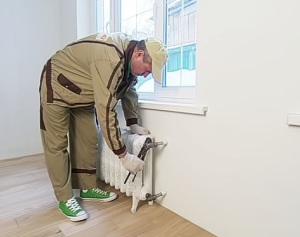
Modern manufacturers did not stop producing cast-iron heating radiators. It's just that their design has changed radically. Now on the market you can see radiators made both antique and made according to modern design.
In most urban heating networks, pressure is usually very high, and, on the contrary, heat transfer fluids are not of very good quality. And cast-iron heating radiators fit perfectly into this heating network. Thick cast-iron radiator walls can easily withstand high pressure for several decades, their use is possible even if steam is used for heating at a temperature of about 150 degrees. And corrosion of cast-iron radiators is not terrible.
Cast iron radiator installation diagram
When at the end of spring the water is drained for maintenance work, they tolerate the airing of the system well. In the event of a power outage, cast-iron batteries continue to provide heat, as they cool down much more slowly than other radiators from other materials. Installation of a cast-iron heating radiator. Video
Of course, cast iron radiators have some disadvantages, but there are no ideal things. The first disadvantage of cast iron radiators is their weight. They weigh a lot, which means that their installation will require a lot of physical effort. You cannot install such batteries yourself. Since this type of radiator is usually hung on the wall, you should make sure that the wall can support the weight of the radiator, which, after installation, will also be filled with water. It may be worth purchasing a radiator model with additional legs.
The larger the cast iron batteries in size, the higher their heat capacity, the slower they cool down. If you purchase narrow cast-iron batteries, then their weight, of course, can and will be less, but both heat transfer and inertia will also decrease.
Despite the disadvantages, the advantages are still too good to refuse to install these wonderful heating devices. In addition, modern manufacturers produce radiators of various shapes and colors. The design of modern radiators is not only familiar to our understanding of the accordion, models are produced with a smooth surface, with extended gaps between the sections. The expansion of the gaps allows you to increase heat transfer to some extent. There are also models made in the form of columns.
Cast iron batteries will be relevant for a very long time. And thanks to the design work on their appearance, they can easily complement any interior. But the most important thing is that the house will be very, very warm.
How useful was the information for you?
Choosing a bracket for a new heating radiator
When installing or replacing batteries yourself, it becomes necessary to select related equipment. One of the fastener elements is a bracket that allows you to securely fix the heating radiator and thereby ensure the proper operation of the entire system. The latch is a galvanized steel hook with a round or rectangular section, at the other end of which there is a mounting plate or thread.
The correct choice of brackets is very important, because the equipment should not be allowed to sag, collapse from sudden seismic activity or from an accidental impact.
Types and application of holders for radiators
Batteries are made of copper, aluminum, cast iron and bimetal (their inner layer is made of steel, the outer layer is aluminum). They are either suspended from the wall or rest on floor installations, it is possible to combine these options. Some fasteners can be adjusted in height, length. There are many types of brackets, divided into 2 large groups:
- pin (anchor) fixed (short and long) holders for bimetallic or steel radiators;
- height-adjustable (range of changes about 20 mm) with a mounting plate, allow you to hide mounting errors, uneven surfaces or hang perfectly horizontally batteries with a large number of sections (more than 6);
- corner - for small or light heating elements.
There are also anti-noise holders, with a special coating (rubberized). Specifications of this bracket for mounting radiators: material - steel, diameter - 7 mm, can withstand weight up to 82 kg. They are usually taken for bedrooms so that there is no audible small tapping that occurs in the equipment when heated.
Tricky meter that saves electricity Pays for itself in 2 months!
2. Overview of brackets for mounting a floor radiator.
They are in the form:
- independent stand with a sole, used for massive structures that are impractical to hang, for example, near a too thin (plasterboard) partition or display windows;
- additional for batteries bolted to the wall - these are the most suitable brackets for cast-iron radiators;
- racks with hooks that can be screwed to the floor and to the wall; It is also intended for overall equipment, but is used to distribute the load between planes (for example, in a wooden house).
Floor holders can also be height-adjustable. There are options:
- in the form of a stand without fixing the radiator;
- with additional holding elements: with a chain or collar;
- on a sole or on a tripod, can be screwed to the floor or simply placed on it.
